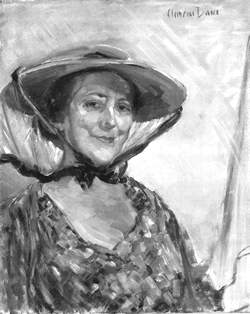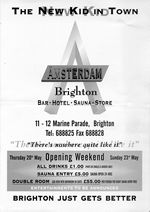

Issue 11 . Spring 2002
Lucky for Some . The Presents of the Past . Come Into My Web . Hippy Happy Birthday . Wonderful, Wonderful: Some Memories of Edward Thompson
The Presents of the Past
As Brighton & Hove mutates again before our very eyes, and a fresh crowd of incomers runs around the 'city', exclaiming as though they had discovered it all for themselves, and we wait for the winds to blow away their rough edges, it is good to look back at queer history and realise that some things stay more or less the same and others come back in different forms.
The past is all about us, here, down by the sea. Layer upon layer of the stuff. To take one example we need only look at that stretch of Marine Parade running eastwards from the Steine, heavily ornamented with gay establishments in the last few years, from Revenge on the corner overlooking Palace Pier to Kruze, Charles Street and Pool, followed by Amsterdam then Legends and the New Europe Hotel. This glittering necklace may appear to be a new phenomenon but it's not. Or not entirely, anyway.
White piano
Fifty-odd years ago there were two famous gathering places here. The downstairs bar of the Marine Hotel (at Numbers 13 and 14 Marine Parade, across Broad Street from what is now the Amsterdam) saw some very entertaining and wild sessions, while at Numbers Six and Seven of the Parade (on the site now occupied by Kruze and the Albemarle flats) was the Albemarle Hotel where the groundfloor bar was known as the White Room. Norman was in charge of the tunes at the white piano and the venue was particularly popular on a Sunday morning when it would fill with twilight people recovering gently from the excesses of the night before.
Lesbian and gay venues come and go with unpredictable speed, and the meetings and partings that happened in and around them may seem to have been forgotten, yet there are plenty of people around today who treasure their memories of the Marine and the Albemarle. The sound of the feet that trod these streets goes on echoing, 'choing, 'oing. It is blown about a bit by the years, which introduce their own distortions, but when we listen to stories of the old days the past is alive again. Can you hear it? Can you hear? You can.
Going further back still in time, Number 11 Marine Parade was the setting for much of the action in Clemence Dane's novel, The Moon is Feminine, first published in 1938. It's a spooky, multi-stranded and deeply queer tale about a love triangle between a bachelor, a spinster and a kind of merman, and really ought to be mentioned in the same breath as Graham Greene's Brighton Rock as one of the great evocations of the town's psychological atmosphere - floating, eccentric, hallucinatory, full of promises and dreams but also troubles and sadnesses.

Dustwrapper of the first American edition of The Moon is Feminine (New
York: Doubleday Doran, 1938). Dane knew North America too. Brighton &
Hove is a strange mixture of the provincial and the cosmopolitan, a collection
of permeable parishes with global connections.
There's lots in the book to intrigue an audience of lesbian, gay, bisexual and transgender people as we ponder the challenges of living in this place in this, the first decade of a new century. Here is Dane's description of Brighton Pavilion in 1806, 'a leafless, an artificial wood':
Behind
the artificial glimmered the impossible. There were soap-bubble domes
dwindling into minarets, and minarets swelling at their peaks into soap-bubble
domes again. There were rows of secret windows leaded with Cupid domes.
There was movement, there was colour, there was curve, curves of music,
curves of wit, evasive curves of power. Everywhere there was proportion
and not a moral anywhere.
[London: Heinemann, 1938, page 256]

'I seek the tales which drift about the land.' Self-portrait by Clemence Dane (died 1965) artist, novelist, dramatist, screenwriter, traveller and lover of Brighton. She lived with her companion Olwen Bowen Davies (died 1986) in London and at their Sussex address: The Caravans, Midhurst.
Dane's real name was Winifred Ashton. Edward Thompson, a Hoveite and a mainstay of Brighton Gay Switchboard for many years (see obituary in this issue), knew her well and described her as the most beautiful woman he had ever seen. It is said she took great care with The Moon is Feminine to make the geographical action as truthful and accurate as possible, pacing the distances from building to building and back again.

Flyer for the opening weekend of the Amsterdam, 1999.
Number 11 Marine Parade is now occupied by one half of the Amsterdam (the westward or lefthand half looking inland with your back to the sea). Today it's possible to sit and drink in the balconied room where Dane's hero, the Green Man, faced the complicated loves he felt. It might be an idea if the novel itself were available to readers on the premises, a single copy perhaps, tearstained and chained to the bar.
Gorgeous flux
That's the end of this short tour. Put your hands together please for Brighton & Hove, a place with no clear edges. A good part of it is fringes which have moved to the middle and are in gorgeous flux. With that thought in mind BOP will go on exploring the possibilities of future growth, mapping and recording the national and international dimensions of this extraordinary city. Watch this space.
Back to top of page
Back to Ourstory home page